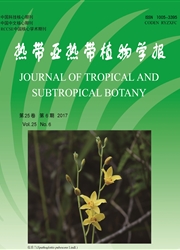

 中文摘要:
中文摘要:
为探讨福建省三明市马尾松人工林淋溶液中水溶性有机物(DOM)的溶解特征和光谱学特征,以马尾松(Pinus massoniana)和芒萁(Dicranopteris dichotoma)鲜叶、未分解层(L层)和半分解层(F层)凋落物为研究对象进行室内淋溶,对淋溶液中的水溶性有机碳(DOC)、水溶性有机氮(DON)与水溶性有机磷(DOP)含量和紫外光谱(SUVA)、荧光光谱指标和红外光谱(FTIR)等特征进行研究。结果表明,在24 h内,随着淋溶时间的延长,DOM含量呈现有波动的上升趋势;芒萁除鲜叶的DOC含量显著高于马尾松外(P〈0.01),其余DOM含量均小于马尾松。两植物F层DOM的SUVA值和腐殖化指标(HIX)都显著高于鲜叶和L层(P〈0.05),表明F层的芳香性化合物含量和腐殖化程度越来越高。DOM的同步荧光峰值显示淋溶液中含有类蛋白和类富里酸荧光团。两植物的红外光谱显示有5个相似的吸收谱带,强度最大的吸收来自于H键键合的-OH的伸缩振动,同一植物3种样品之间红外吸收的差异证明从鲜叶-L层-F层凋落物的共轭体系逐渐增大,结构更复杂。因此,随分解进程两植被DOM的化学结构越来越复杂;马尾松较芒萁含有更多的DON和DOP,这一方面为微生物提供了更多的养分,另一方面又增加了底物分解的难度。
 英文摘要:
英文摘要:
In order to understand the soluble and spectral characteristics of dissolved organic matter (DOM) in leaching solution of 37-year-old Pinus massoniana plantation in Sanming, Fujian Province, subtropical China, the soluble and special characteristics of DOM from fresh leaves and litter-fall in L and F layers from Pinus massoniana (PIM) and Dicranopteris dichotoma (DID) were studied. The results showed that the DOM content, including dissolved organic carbon (DOC), dissolved organic nitrogen (DON) and dissolved organic phosphorus (DOP), increased with lfuctuation along leaching time from 3 to 24 hours. DOC content of fresh leaves of DID was signiifcantly higher than that in PIM (P〈0.01), while DON and DOP are lower. The special ultraviolet-visible absorption (SUVA) and humiifcation index (HIX) of DOM in F layer litter of both species was signiifcantly higher than that in fresh leaves and L layer litter, it indicated that F layer litter contained more aromatic substances and high humiifcation degree. Synchronous lfuorescence peak showed DOM contained protein-like and fulvic acid-like lfuorophore. The six kinds of samples showed ifve IR absorption bands in common, with the strongest absorption in all cases arising from stretching vibration of H-bonding hydroxyl groups. The infrared absorption differences between three kinds of samples in the same stand supported that the conjugated systems grown larger from the fresh leaves to L layer litter to F layer litter. Overall, the chemical structures of DOM are more complex in more decomposed samples, and the PIM contains more DON and DOP than DID. On the one hand, it provide more nutrients for microorganisms, on the other hand, it increase the dififculty of the decomposition of the substrate.
 同期刊论文项目
同期刊论文项目
 同项目期刊论文
同项目期刊论文
 期刊信息
期刊信息
